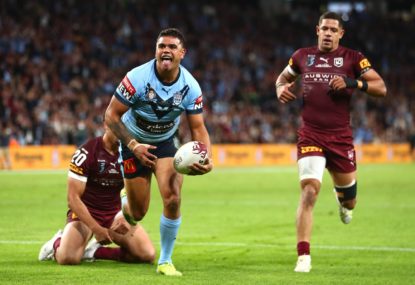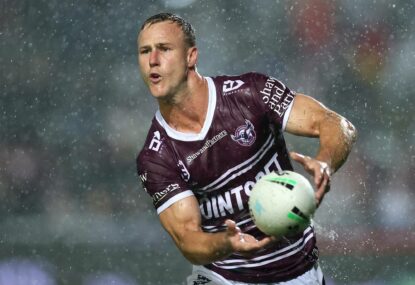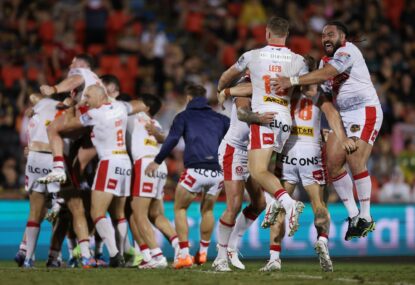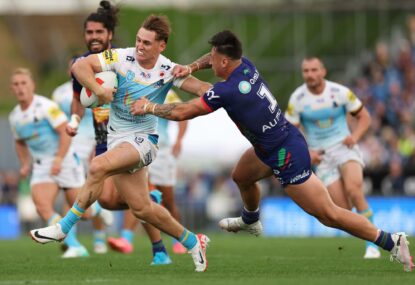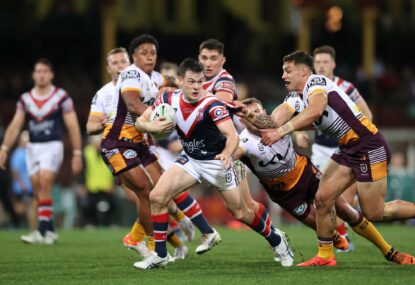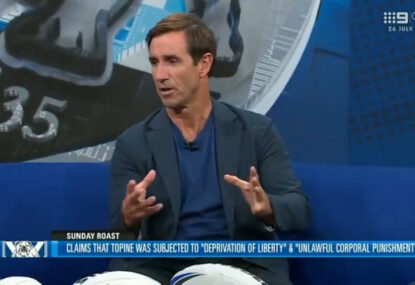It’s early March and I’m sitting on the hill at Davies Park, a beautiful suburban football ground nestled next to the river in the West End of Brisbane.
These days, Davies Park is home to the Souths-Logan Magpies in the Queensland Cup, but in years gone by, when Gary Belcher and Peter Jackson and Mal Meninga were going around, the club was just Souths.
Today, there are over a thousand people on hand to watch a game of rugby league, and it’s clear as soon as the two teams run out who the majority of people are here to see. When the Papua New Guinea Hunters enter the field applause echoes from all parts of the ground, when the Magpies follow a smattering of handclaps float down from the hill and out of the leagues club.
The home team are not the stars of the show today.
On this particular afternoon, the Magpies get belted by a Papua New Guinea side intent on showing off Harlem Globetrotter-like ball handling. They run in a bunch of tries that originate from deep in their own territory. The Maggies show a lot of heart but it’s clear there’s plenty of improvement required for the season ahead.
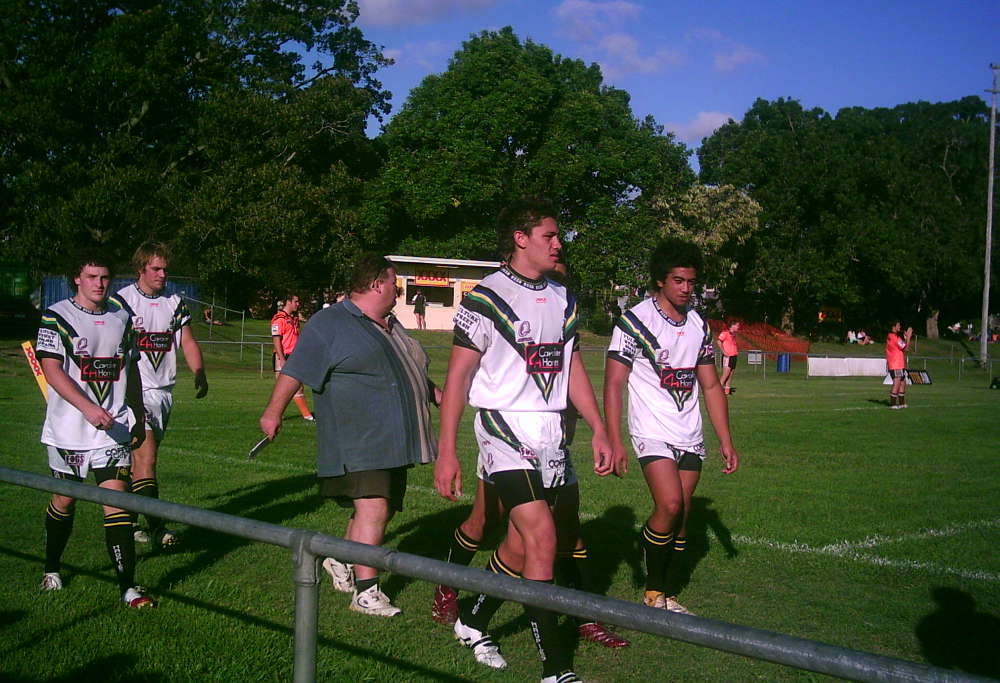
Souths Logan colts players at Davies Park in Brisbane (Photo: David Jackmanson, Flickr)
After the game my friends and I retire to the air-conditioned sanctuary of the Leagues club and discover that jugs are only 11 bucks. The price in the clubhouse puts the can bar on the hill to shame, but there’s a special kind of joy that sitting in the hot March sunshine in Brisbane, working up a slick sheen of sweat and sucking back cans of XXXX Gold with the coterie of other locals.
There’s a distinct charm to the modesty of the clubhouse and as the first grade team files in after their showers you get the sense that even if there aren’t droves of Souths-Logan supporters turning up these days, there’s still a sense of community that ties the place together.
That when one of the old timers who’s been coming to games for years shakes hands with the rookie front row forward it actually means something to them that they’re both here.
Last Wednesday, Steve Mascord wrote a gem of an article about the future of the QLD and NSW rugby league administrative bodies in the face of the all-powerful, all-conquering cashed up NRL behemoth.
Given the size of the war chest assembled by the Australian Rugby League Commission and the strategic direction outlined by Mascord, it seems that it will only be a matter of time before the state league organisations are dissolved as shareholders of the Commission and the ARLC machine takes on the responsibility of running rugby league at all levels of the game; from the grassroots through to A-Grade in the national competition.
Unlike several other teams in the Queensland competition, Souths-Logan does not have a shiny new Leagues club. While the Tigers at Langlands Park, or the Dolphins out at Redcliffe, are fed money through their pokie-laden establishments, at Davies Park the best you can hope for is that reception on the lone TV in the bar holds up long enough to see the NRL game being played on delay.
The future of Souths-Logan, in contrast to the West End area of Brisbane that it’s situated in, seems unclear. In a place where land values are increasing at mind-boggling rates and the population of affluent young white collar-types continues to grow, the Souths-Logan football club is struggling for relevance.
If the Commission was to take control of the state administrative bodies, the decisions being made about the future of Souths-Logan and the future of Sunday afternoons at Davies Park would likely take place in a meeting room in Sydney somewhere instead of at the head office of Queensland Rugby League.
Financials and attendance and population growth and target markets and prospective viability and all be on the agenda, and probably rightly so; for only a fool is caught on the wrong side of history. But by all accounts the NRL’s model to grow the game will take a ‘for the greater good’ approach and there will, no doubt, be casualties.
Under a centralised model, less well-off clubs in the state competitions would no longer be so reliant on affiliate relationships with NRL clubs to ensure their existence. While the current state bodies administer grant payments to clubs to keep them afloat, it’s the Leagues clubs and sponsorship money and affiliate relationships with NRL clubs that currently determine on-field success in the stage leagues.
In the future, a more likely model of operation would be grants distribution from the Commission-run state body and a fixed alignment and direct pathway from junior talent pools to professional clubs. The alternative is, of course, no formalised alignments for juniors and the introduction of a rookie player draft.
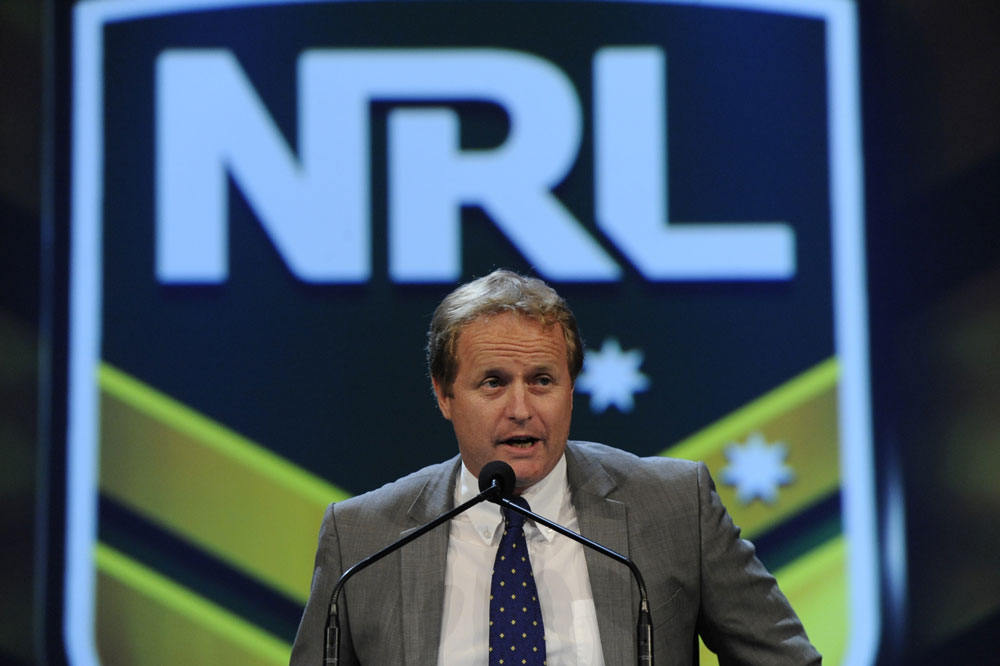 Changes will be made here in the future, not in QRL meetings. Photo: AAP
Changes will be made here in the future, not in QRL meetings. Photo: AAP
Whichever approach is taken, even if no one is turning up to watch any of the games in the state league, clubs will survive on the strength of their junior development alone. For Souths-Logan, whose junior catchment area includes the league hotbed of Logan, this could prove especially fateful.
However, in the face of any prospective state league takeover by the ARLC, my fear is that we will be left with football clubs at the state level that, as Mascord puts it, are just “shells”; empty organisations with easily replaceable parts and consistent tax returns that exist only to funnel exceptional junior talent to the top level of the game.
While the days of local players running around for a team in the area that they grew up in are dead, hopefully the history and people and passion that local clubs are founded upon won’t go by the wayside as well.
Hopefully the volunteers behind the bar whose lives are intertwined with the club aren’t replaced by anonymous employees of the corporate juggernaut, who arrive to do a job and get their weekly salary, oblivious to the community around them. Hopefully the members whose identity is, at least in part, forged through their connection to the club aren’t simply treated as widgets, whose importance is measured by how much merchandise they buy.
My fear is that by transforming football clubs into ‘shells’, the Commission may destroy the fabric of the clubs themselves. What happens if no one is there to shake the hand of the rookie front rower at the end of the game?
In many ways, the argument in favour of an approach that sees the Commission own and control rugby league at all levels in Australia is hard to argue against. Clubs like Souths, whose success peaked in the mid 80s, and whose near financial ruin forced a merger with Logan in 1994, barely scrape by as it is.
Without financial intervention, and the added firepower of media and marketing resources, it seems inevitable that eventually a club like Souths-Logan will fold, or be ‘relocated’, and apartment complexes will spring up to sully the field where so much blood and sweat has been shed, and so much glory earned. Without intervention, the demise of clubs like Souths-Logan becomes ‘when?’ rather than ‘if?’
There are many clubs just like the Magpies along the Eastern Seaboard of Australia, local clubs whose financial salvation and ongoing operation lies in the deep pockets of the Commission and the continuing success of the NRL.
The potential re-structuring of rugby league under a centralised governing body in Australia also raises a more pertinent question: Do people actually care about the governance of the game and the management of the club that they support?
For the majority of us, our initial engagement with sports occurs when we’re children. Our formative experiences are, literally, just playing the game. As kids, we play sport without any real awareness of the mums and dads running the club behind the scenes, the struggles to get refs or tuckshop volunteers or to keep the club afloat and able to pay the ground staff.
As we get older and change from participants to viewers, our learned obliviousness seems to grow. Are the myths and legends built on the sporting field so sacred that talk of management, dollars and profit margins poison the sporting discussion? Or do we just not care as long as the show goes on?
While there was some noise recently about the legitimacy of the now-Commission-owned Titans outbidding other clubs for Daly Cherry-Evans’ signature, it predominantly came from those within the ranks of other clubs rather than the supporters (aside from some particularly annoyed Cronulla and Canberra fans).
The prevailing mood seems to be that most punters are happy to remain ignorant to the business that sits behind the on-field game as long as they’re served up ‘the product’ each week, on demand, and can enjoy it from the comfort of their own couch.
While the rise in Foxtel subscriptions and the push to move games away from suburban grounds and into city stadia feeds the coffers at NRL HQ, it also drives a wedge between fans and their clubs. These days, being a real supporter is stumping up the $50 a month to view the team’s games live and in HD courtesy of Uncle Rupert.
Even the diehards may eventually struggle to justify the significant travel and exorbitant prices that have come to form part of the live ‘match day experience’.
The reality is that ‘The Game’ is now bigger than the game and that the Commission focusses everything on giving the people what they want (and what makes them money): a top flight NRL competition that delivers a high quality product streamed directly to as many lounge rooms in Australia as possible.
If that means that every grade below the NRL is contested by a network of colourful, meaningless clubs, then so be it. If that means that state leagues exist purely to feed junior players into the machine, then so be it. The NRL is both the jewel in the Commission’s crown, and the sustenance for just about every other local club in the country.
In his book ‘Seeing Like a State’, James C Scott argues against what he calls ‘development theory’; “imperialistic state planning that disregards the values, desires and objections of its subjects”.
Scott argues that “the success of designs for social organisation depends on the recognition that local, practical knowledge is as important as formal, epistemic knowledge.”
In a nutshell, you can’t solve every problem using a top-down approach, local insight is invaluable, and you ignore it at your peril.
With this in mind, in the Commission’s quest for NRL growth and stability through uniformity, I just hope that it considers how the application of a blanket business model – one that turns every local outfit into a cookie-cutter club with replaceable parts designed to produce human athletic capital – can retain the identity of local clubs and support their unique roles within local communities.
Perhaps the Commission won’t want to, or be able to. Perhaps it’s an incompatible concept. Perhaps I’ll just have to confront the reality that what I love about footy isn’t what other people love; that most people don’t want to think about the importance of local clubs being unique, or why people support a team, or how a rugby league club fits into the local community.
Perhaps I have to admit that what most people want is to watch top-flight footy and have fireworks and mascots and cheerleaders and pop music and think of nothing beyond the colours of their team, the superstars of the game and the points on the scoreboard.
What I want is as simple as the black and white strip worn by the Magpies; to sit on the hill and watch the footy at Davies Park. The irony is, because most people want all those other things, I’ll probably get what I want for many years to come too.
Follow Brin on Twitter: @brinpaulsen





























































































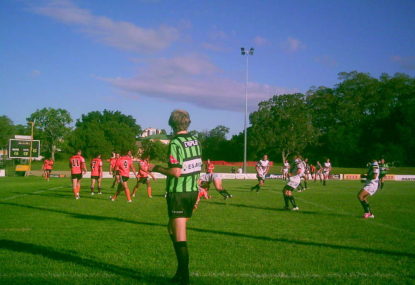

 Changes will be made here in the future, not in QRL meetings. Photo: AAP
Changes will be made here in the future, not in QRL meetings. Photo: AAP